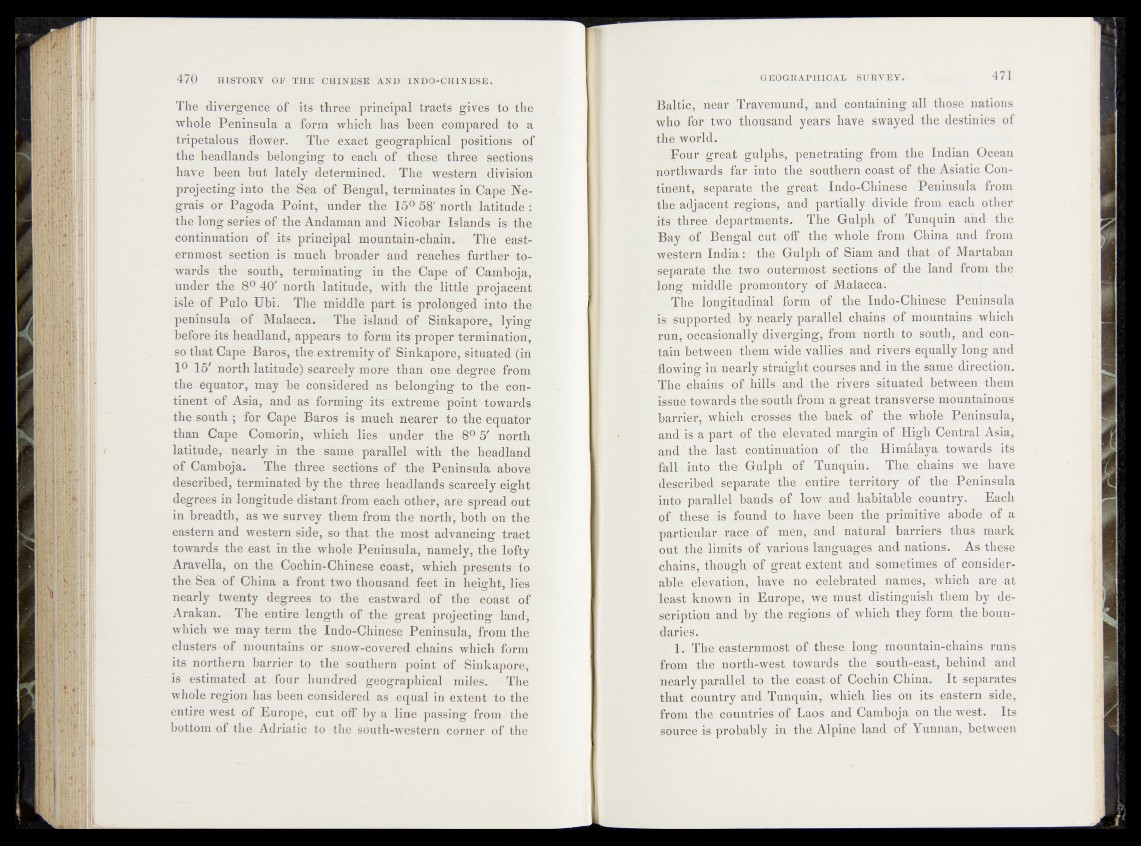
The divergence of its three principal tracts gives to the
whole Peninsula a form which has been compared to a
tripetalous flower. The exact geographical positions of
the headlands belonging to each of' these three. sections
have been but lately determined. The western division
-projecting into the Sea of Bengal, terminates in Gape Ne-
grais or Pagoda Point, under the 15° 5 8 'north latitude:
the long series of the Andaman and Nicobar Islands is the
continuation of« its principal mountain-chain. The easternmost
"section: is much broader and reaches further towards
the south, terminating in the Cape of Camboja,
under the 8° 40' north latitude, with the little projacent
isle-of Pulo Ubi. The middle , part is prolonged into the
peninsula, of Malacca. The island of Sinkapore, lying
hefore-ifes headland, appears to form it&’proper~termination,
so that Cape Baros, the extremity of‘ Sinkapore,« 'situated (in
1° 15' north latitude) scarcely more . than one degree from
the-equator, may be considered as belonging- to the continent
of Asia, and as forming its^extreme point" towards
the south ; for Cape Baros is much nearer to*1 the equator
than Cape Comorin, which lies under the fS°?5* north
latitude, nearly in the same parallel- with the headland
of Camboja. The three sections of the Peninsula? above
described, terminated by the three headlands scarcely eight
degrees in longitude distant from each other, >ar.e- spread nut
in breadth, as we survey them from the north1, both om the
eastern and western side, so that the most advancing tract
towards the east in the whole Peninsula, namely, the lofty
Aravella, on the Cochin-Chinese coast, which presents to
the Sea of China a front two thousand feet itr: height, KSei-
nearly twenty degrees to the eastward of the coast of
Arakan. The entire length of the great projecting land,
which we may term the Indo-Chinese Peninsula, from the
clusters-of mountains or snow-covered chains which form
its northern barrier to the southern point of Sinkapore,
is estimated at four hundred geographical miles. The
whole region has been considered as equal' in extent to the
entire west of Europe, cut off by a line passing from the
bottom of the Adriatic to the south-western corner of the
Baltic, near Travemund,- and containing all those nations
who for: two, thousand years have swayed the destinies of
the world.
. Four great gulphs, penetrating from the Indian Ocean
northwards far injsp^the southern coast of the Asiatic Continent*
*-separate the .great Indo-Chinese Peninsula from
the adjacent regions, and partially divide from each other
its three departments. The Gulph of Tunquin and the
Bay of Bengal cut-off the whole from China and from
western India: the Gulphfpf Siam and that of Martaban
Separate the tvio .outermQ^sectionstpf the land from the
long middle promontory of Malacca;
fjr. The longitudinal form of the. Indo-Chinese Peninsula
Is supported by nearly parallel chains of mountains which
run, occasionally diverging!from .north, to« south, and contain'
feetweenyt J&gm wide vallies, and rivers, equally long and
flowing in nearly straight courses and in the same direction.
The chains of hills.«iand the, -rivers situated,between, them
isspei towards the s©uth*fr*p.m a great transverse mountainous
^barrier; which crosses »the h^khof- the whole Peninsula,
and is a part, of the elevated margin of lligh.Central Asia,
and th e ) |^ t pontinuationn of » the . Himalaya, towards its
fall into. the^ Gulph of Tunquin. The. chains we haye
described -separate the . entire territory of the Peninsula
mlp parallel glands of low and; hahitable^cpuntry.Each
of thesekis found to have been the'primitive abode of ,a
particular race of;: men, and natural barriers thus mark
out-.the-'limits of various languages and nations. . As these
chains,' though of great extent; and sometimes .of considerable
^evatiop, have no celebrated namgs> which are at
least known in Europe, we must distinguish them by description
and by the regions of whid^they form the boundaries.
>-
, . 1. The easternmost of those*-long mountain-chains runs
from the north-west towards the south-east, behind and
nearly parallel to» the,vcoast of Cochin China. It separates
that :.country and. Tunquin, which lies on. its . eastern side,
from the countri.es of Laos and Camboja on the west. Its
source is probably1 in the Alpine land of Yunnan, between